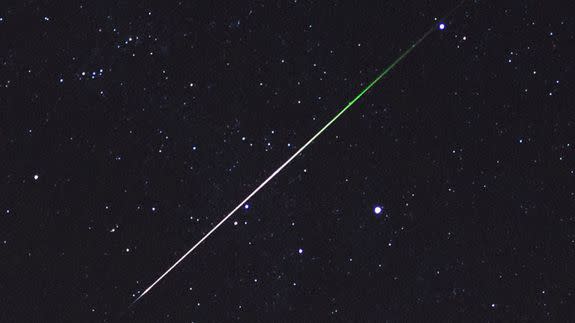Cops aren't taking a mysterious 'fireball' in the sky very seriously

Residents in the Australian town of Gladstone, Queensland, got a shock Monday evening when a fiery object lit up the night sky accompanied by a loud "boom" and a tremor.
But the biggest news? No one knows exactly what went down yet, and even the police are making light of the mysterious, erm, light.
SEE ALSO: Two bright meteors streak above Earth in new video from space
According to the Gladstone Observer, Bureau of Meteorology spokesperson Meredith Schier was unsure what caused the incident, saying, "There doesn't seem to be a weather related explanation for what has been described in the Gladstone area tonight."
Mystery surrounds reports Queensland residents witnessed a meteorite overnight. @SimoLove https://t.co/hh4B3VH2zM https://t.co/UEMgJfIctY
— 7 News Queensland (@7NewsQueensland) September 26, 2016
Similarly, Geoscience Australia confirmed to Mashable that they detected no earthquake activity in the area at the time. Police say they've been told by the Civil Aviation Safety Authority that no planes were reported missing or in danger in the region. Spooky!
Hundreds of Queensland residents have reported sightings of a bright light in the sky, followed by a loud bang and tremors.
Two hours after the initial "bang," Geosciences Australia did measure a 3.8-magnitude earthquake off Airlie Beach, which is six hours north of Gladstone by car.
For their part, police are playing it cool. Good to see that just like the rest of us, they're not above alien jokes.
No, we don't know anything about a meteor shower near Gladstone, but we know some people who might. #TheTruthIsOutThere pic.twitter.com/ENESz20XFv
— QPS Media Unit (@QPSmedia) September 26, 2016
One local man talked to Yahoo News about his sighting of the possible meteorite, saying he was "sitting at the beach in Boyne Island and saw it all unfold, looked like a big as hell shooting star and lit up the beach."
"Then about a minute later a big bang and a shockwave came over the water and shook my car little bit was a pretty awesome experience," he said.
Education program producer at the Sydney Observatory, Geoff Wyatt told Mashable "We are bombarded by these [meteors] every day. Approximately 50,000 per year with as little as 0.8% probability of them being spotted from inhabited areas ... Certainly objects do break up and survive until they reach sea level but that’s it, most go into the sea."
The incident was reportedly witnessed by people over an area of 400 kilometres (248 miles).
Harvard astrophysicist Jonathan McDowell told the Gladstone Observer it was indeed likely a meteor. "It's not a comet, or Queensland wouldn't exist anymore (and we'd have seen it coming for days)," he said.
"It is probably a large meteor. I'm guessing a rock about a metre across which would have been big enough perhaps to leave fragments (meteorites) on the ground."
Mashable has reached out to the Bureau of Meteorology for comment.
